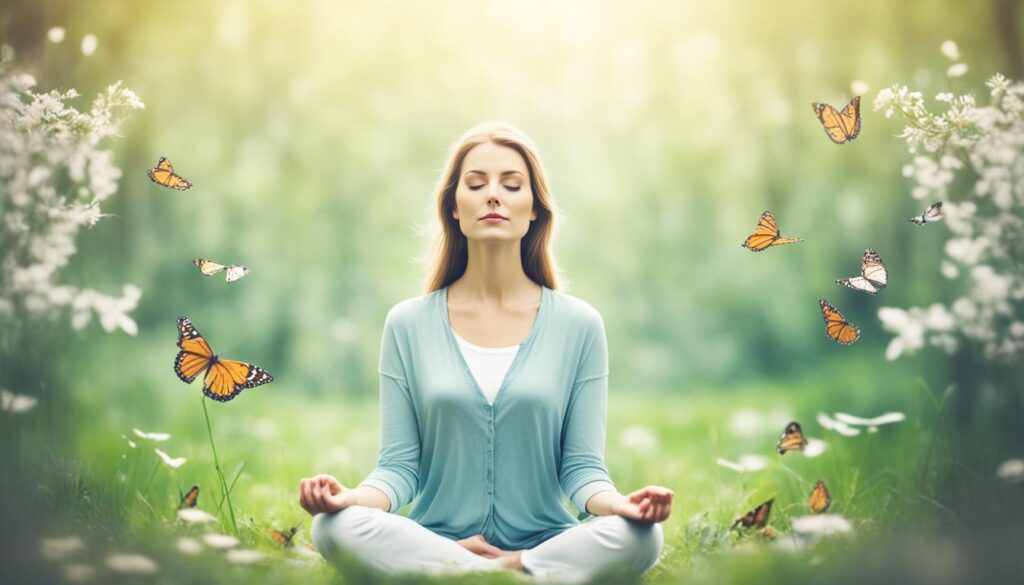Have you ever yearned for a brief moment of tranquility? A moment when the hustle and bustle of the world quiets down, leaving you in a peaceful calm? There was a period in my life when the pressures of everyday life overwhelmed me, as I tirelessly pursued success and approval from others. It felt like I was trapped in an endless race with no end in sight.
But then, I stumbled upon the concept of stillness of mind. It was like discovering a hidden oasis in the midst of a desert. Stillness became my sanctuary, a place where I could find solace and reconnect with my inner self. In this space of tranquility, I discovered a profound sense of peace that touched not only my mind but my entire being.
Stillness of mind is more than just a fleeting moment of calm. It is a state of being that allows us to tap into a deep wellspring of peace and serenity within ourselves. It is a pathway to inner equilibrium, where the mind becomes still and the heart finds solace. This journey towards stillness is unique for each individual, but it is a path that holds the potential for transformation and profound personal growth.
Join me as we explore the essence of stillness of mind and uncover the roadmap to achieving it. Together, we will unravel the elusiveness of stillness, chart a pathway towards tranquility, and understand the role of stillness in our personal evolution. Along the way, we will discover the power of breath, the essence of silence, and the healing embrace of nature.
So, take a deep breath, let go of the outside noise, and embark on this journey with an open heart and mind. The key to unlocking stillness of mind lies within each of us, waiting to be discovered and embraced.
Key Takeaways:
- Stillness of mind is a sanctuary of serenity and equilibrium that exists within each of us.
- It is a state of inner calm and tranquility that brings psychological and physiological benefits.
- The journey towards stillness requires understanding the primacy of pausing and comprehending the concept of stillness.
- Stillness often feels elusive in a world filled with distractions and sensory overload.
- There are various pathways to stillness, including creating a personal sanctuary, practicing mindfulness and meditation, and reconnecting with nature.
The Primacy of Pausing
When life becomes overwhelming and our minds are consumed by endless thoughts and worries, it is essential to discover the power of pausing. Pausing is not merely the absence of action; it is a deliberate relaxation technique that allows us to ease the tensions within ourselves.
By taking a moment to pause, we give ourselves the opportunity to step back and reconnect with our breath. The breath becomes our anchor, guiding us into a state of calm and stillness. As we immerse ourselves in the rhythm of our breath, we create space within, allowing the mind to orchestrate a symphony of silence.
This symphony of silence is where true relaxation and tranquility reside. It is a profound presence that soothes our souls and eases the burdens we carry. In this realm of stillness, we find respite from the constant pressures and noise of modern life.
“In the midst of movement and chaos, keep stillness inside of you.” – Deepak Chopra
The Importance of Pausing
Pausing is not a luxury; it is an essential element of self-care and well-being. In the fast-paced world we live in, we often neglect to prioritize our mental and emotional health. Pausing allows us to restore balance and reconnect with our inner selves.
Through the primacy of pausing, we can:
- Relieve tension: By taking a pause, we release the accumulated tensions in our bodies and minds, making way for relaxation and ease.
- Restore focus: Pausing helps sharpen our mental clarity and brings us back to the present moment, enabling us to concentrate on what truly matters.
- Cultivate mindfulness: The act of pausing encourages us to be fully present, aware of our thoughts, emotions, and surroundings, enhancing our ability to practice mindfulness in all aspects of life.
Remember, the realm of stillness and tranquility is accessible to everyone. It is through the primacy of pausing that we can tap into this inner quietude and experience the profound benefits it brings.
| Benefits of Pausing | How to Incorporate Pausing into Your Life |
|---|---|
|
|
Comprehending the Concept of Stillness
Stillness, at its core, is like an inner sanctum within the chaos of daily life. It goes beyond the absence of noise and becomes a profound embodiment of calmness. By harnessing the latent tranquility that permeates our consciousness, we can experience the psychological and physiological benefits of stillness of mind.
“Stillness is not the absence or negation of energy, life, or movement. Stillness is the depth of life.”
In the modern world, it is easy to get caught up in the frantic pace of our daily routines, constantly bombarded by external stimuli and overwhelmed by our own thoughts. Yet, within each of us lies an inherent capacity for stillness, a sanctuary of calmness waiting to be discovered.
Stillness offers a respite from the bustling world around us, allowing our minds to retreat to a place of tranquility. It is in these moments of inner quietude that we can find solace and rejuvenation, as our senses become attuned to the subtle rhythm of our breath and the gentle whispers of our heart.
Inner sanctum is an apt metaphor for stillness, as it represents a sacred space within ourselves, shielded from the noise and distractions of the external world. It is a place where we can cultivate a deep sense of calmness, reconnect with our inner wisdom, and gain clarity amidst the chaos.
By embracing stillness, we create a pathway to a calmer mindset. In this state, we can access our innate resilience and tap into the wellspring of creativity and inspiration that lies within us. Stillness allows us to navigate life’s challenges with greater ease, as we become more attuned to our own needs and inner guidance.
“Calmness is the cradle of power.”
Within this realm of calmness, we can experience a profound shift in our overall well-being. Physiologically, studies have shown that stillness of mind can reduce stress levels, regulate blood pressure, and improve immune function. Psychologically, it cultivates a sense of clarity, emotional stability, and heightened self-awareness.
As we comprehend the concept of stillness, we are reminded of its transformative potential. It is a sacred refuge within us, waiting to be nurtured and embraced. By dedicating time and effort to cultivate stillness, we can unlock the true essence of tranquility.

Connecting with Stillness in Nature
Nature has long been associated with a sense of tranquility and stillness. The peacefulness of a lush forest or the serenity of a pristine beach can evoke a profound sense of calmness within us. Spending time in nature allows us to connect with the natural rhythms of the earth and find solace in its harmonious presence.
“In nature, nothing is perfect and everything is perfect. Trees can be contorted, bent in weird ways, and they’re still beautiful.”
Whether it’s taking a peaceful walk in the woods, meditating beside a babbling brook, or simply basking in the warmth of the sun, immersing ourselves in nature can be a powerful way to cultivate stillness. The sights, sounds, and smells of the natural world awaken our senses and invite us into a state of profound calmness and tranquility.
| Nature’s Gifts for Stillness | Benefits |
|---|---|
| Green spaces | Reduced stress, improved mood |
| Forest bathing | Enhanced immune system, increased relaxation |
| Ocean waves | Deep relaxation, enhanced creativity |
As we immerse ourselves in the beauty of nature, we can connect with the stillness that exists both within us and in the world around us. It is a reminder of the inherent calmness that resides in every moment and the profound serenity that comes from embracing the present.
In the next section, we will delve into the elusiveness of stillness in our modern lives and explore the factors that contribute to its fleeting nature.
The Elusiveness of Stillness
Stillness often feels elusive in a world filled with audible distractions, digital notifications, and internal turmoil. The constant demands of modern life can make it challenging to find moments of peace and quiet. However, understanding the factors that contribute to the elusiveness of stillness can help in the pursuit of tranquility.
Our daily lives are bombarded with distractions that pull our attention away from the present moment. Whether it’s the constant buzzing of smartphones, the beckoning allure of social media, or the never-ending to-do lists, these distractions create a sensory overload that hinders our ability to seek stillness. With so many digital companions vying for our attention, finding moments of uninterrupted peace can seem like an impossible task.
Moreover, the fast-paced nature of today’s world often leads to a heightened state of stress and restlessness. The busyness of our lives can generate internal turmoil, preventing us from experiencing the calmness and tranquility that stillness offers. Our minds become consumed by thoughts of past regrets or future anxieties, leaving little room for stillness to flourish.
Amidst the chaos and noise, it’s crucial to recognize the importance of carving out space for stillness in our lives. By doing so, we can connect with our inner selves, find solace in the present moment, and experience a deeper sense of peace.
By acknowledging the elusiveness of stillness, we can begin to take intentional steps towards reclaiming moments of tranquility. Disconnecting from our digital companions, creating boundaries around our time and energy, and setting aside specific periods for stillness can help us break free from the cycle of distractions and find inner calmness.
The path to stillness requires discipline and a conscious effort to prioritize our well-being amidst the chaos. It’s time we reclaim the power of stillness and make space for it in our daily lives.

The Elusiveness of Stillness: A Comparison
| Distractions | Sensory Overload | Digital Companions | |
|---|---|---|---|
| Effect | Audible distractions divert our attention, making it challenging to find stillness. | An overwhelming amount of stimuli can overwhelm our senses and cloud our minds. | Constant notifications and the allure of digital platforms disrupt our focus and inner calmness. |
| Solution | Creating boundaries, disconnecting from distractions, and practicing self-discipline can help minimize their impact. | Seeking out environments with less sensory stimuli and engaging in relaxation techniques can promote a sense of stillness. | Establishing digital detox periods, setting notifications to silent, and consciously reducing screen time contribute to finding stillness. |
Charting a Pathway to Stillness
The journey towards stillness of mind does not have to be arduous. There are various pathways that individuals can follow to cultivate tranquility. By incorporating mindful practices into our lives, we can create a harmonious balance that allows us to find peace and serenity.
Create a Personal Sanctuary
One effective way to cultivate stillness is by creating a personal sanctuary within our environment. This can be a dedicated space in our homes where we can retreat from the hustle and bustle of daily life. Fill this space with items that bring you joy and promote a sense of calmness, such as plants, soft lighting, and comfortable seating. This sanctuary can serve as a physical reminder of the importance of finding moments of tranquility.
Integrate Moments of Quietude
Incorporating moments of quietude into our daily routine is crucial for achieving stillness of mind. Set aside dedicated time each day for mindfulness and meditation. Find a quiet space where you can focus on your breath and let go of the distractions around you. These moments of solitude will help clear the mind and create space for inner peace to flourish.
Practice Mindfulness and Meditation
Mindfulness and meditation are powerful tools for quieting the mind and experiencing a deep sense of stillness. Engage in mindfulness practices throughout the day, such as mindful eating, walking, or simply observing the present moment with non-judgmental awareness. Additionally, establish a regular meditation practice to cultivate a greater sense of calm and clarity. Start with just a few minutes a day and gradually increase the duration as you become more comfortable.
Engage in Digital Detoxification
In today’s digital age, it is essential to disconnect from the constant stream of information and stimuli. Engaging in regular digital detoxification can help quiet the mind and create space for stillness. Set boundaries around your technology use, such as implementing screen-free hours or designating specific days for a complete digital detox. Use this time to engage in activities that promote tranquility, such as reading, journaling, or spending time in nature.
Reconnect with Nature
Nature has a profound impact on our well-being and is a powerful pathway to stillness. Take time to immerse yourself in the natural world by going for walks in the park, exploring hiking trails, or simply sitting by a peaceful body of water. In nature, we can find solace and reconnect with our true selves. The sights, sounds, and beauty of the natural world have a way of soothing the mind and promoting a sense of tranquility.

| Pathway to Stillness | Benefits |
|---|---|
| Create a Personal Sanctuary | – Promotes a sense of calmness – Provides a physical reminder of the importance of stillness |
| Integrate Moments of Quietude | – Clears the mind of distractions – Creates space for inner peace |
| Practice Mindfulness and Meditation | – Quiets the mind – Cultivates a greater sense of calm and clarity |
| Engage in Digital Detoxification | – Promotes disconnection from constant stimuli – Allows for a break from technology and information overload |
| Reconnect with Nature | – Soothes the mind – Promotes a connection with our true selves |
The Role of Stillness in Personal Evolution
Stillness plays a vital role in personal evolution, fostering creativity, productivity, psychological well-being, and introspection. It acts as a powerful tool for self-discovery, allowing individuals to connect with their intrinsic selves and embark on a transformative journey of growth.
When we embrace stillness, we create space for our inner creativity to flourish. In the quiet depths of our minds, innovative ideas can take root and bloom. By silencing external distractions and honing our focus, we can tap into the wellspring of inspiration that lies within us.
Moreover, stillness enhances productivity by providing us with mental clarity and focus. When our minds are calm and settled, we can approach tasks with heightened concentration and efficiency. This state of flow allows us to accomplish our goals with ease and precision.
Psychological well-being is also nurtured through the practice of stillness. Taking moments of quietude to reflect and introspect allows us to gain insight into our thoughts, emotions, and desires. This self-exploration deepens our understanding of ourselves and promotes a sense of inner peace and contentment.
“In the midst of movement and chaos, keep stillness inside of you.”

The power of stillness lies in its ability to serve as a mirror, reflecting our true selves back to us. It invites us to delve into the depths of our being and confront our fears, insecurities, and aspirations. Through introspection, we gain a deeper understanding of who we are and what drives us.
Benefits of Stillness in Personal Evolution:
- Enhanced creativity and innovative thinking
- Increased productivity and focus
- Improved psychological well-being and self-awareness
- Facilitates introspection and self-discovery
By embracing stillness as a regular practice, we unlock the potential for personal evolution. It becomes a transformative force that propels us forward on the path of self-growth, leading to a more fulfilling and meaningful life.
| Benefits | Stillness in Personal Evolution |
|---|---|
| Creativity | Allows for the flourishing of innovative ideas |
| Productivity | Enhances focus and efficiency in accomplishing tasks |
| Psychological well-being | Promotes self-awareness and inner peace |
| Introspection | Facilitates self-discovery and understanding |
Unlocking the power of stillness is a personal journey that requires intentional commitment and practice. By incorporating moments of silence and introspection into our daily lives, we can harness the transformative potential that stillness offers. Let us embrace stillness and embark on a path of personal evolution, one that leads to greater creativity, productivity, psychological well-being, and self-discovery.
A Personal Tryst with Stillness
Each individual’s journey towards stillness of mind is unique. It is a personal tryst with tranquility, a challenge of personal growth, and an exploration of one’s inner self. This quest holds the potential to unlock inner peace and serenity, empowering individuals to lead more fulfilling lives.
Forging Ahead on the Path of Stillness
Initiating stillness of mind is just the beginning of a lifelong journey. As we delve deeper into our personal tryst with tranquility, we will continue to discover new insights and experiences. This exploration should be both enlightening and enjoyable, leading to a deeper connection with ourselves and the world around us.
Embarking on the path of stillness is akin to setting sail on an inner odyssey, where each moment becomes an opportunity for growth and self-discovery. It is in this journey that we traverse the landscapes of our inner world, uncovering hidden truths and unraveling the layers of our being.
Throughout this lifelong expedition, we learn to embrace the ebb and flow of life, finding solace in each breath and maintaining equanimity amidst life’s challenges.
“The journey of a thousand miles begins with a single step.” – Lao Tzu
Just as the path of stillness is unique to each individual, so too is the wisdom we acquire along the way. We may find solace in meditation retreats, dive deep into the teachings of mindfulness, or seek serenity through the art of journaling. Whichever avenues we explore, they all contribute to our personal growth and the enrichment of our inner lives.
As we forge ahead on the path of stillness, we become witnesses to the subtle shifts in our mindset, the transformation of our emotional landscape, and the amplification of our understanding of the world. We cultivate a heightened awareness that permeates our interactions, enabling us to approach challenges with composure and navigate life’s twists and turns with grace.

| Journey Milestones | Insights and Experiences |
|---|---|
| 1. Embracing Silence | Finding inner peace through moments of quiet reflection |
| 2. Cultivating Mindfulness | Developing a focused awareness of the present moment |
| 3. Connecting with Nature | Discovering the profound beauty and healing power of the natural world |
| 4. Engaging in Self-Reflection | Gaining insights into our thoughts, emotions, and patterns of behavior |
As we embark on this transformative journey, we realize that stillness is not a destination but a way of being. Each step taken, each moment of introspection, and each realization attained brings us closer to a more profound understanding of ourselves and the world.
With every experience and encounter, we further refine our inner sanctuary, fortifying it with wisdom, compassion, and love. The path of stillness becomes an enlightening pilgrimage, guiding us toward a life of inner peace and fulfillment.
The Power of Breath
The breath is a remarkable and often underestimated tool for unlocking the stillness of the mind. It serves as a bridge between our inner and outer worlds, allowing us to tap into a profound sense of peace and tranquility. Mastering the power of breath enables us to cultivate inner silence, creating a sanctuary of calm within ourselves.
When we focus on the breath, we bring our attention to the present moment, grounding ourselves in the here and now. This simple act of mindfulness helps us let go of distractions and connect with our inner being. With each inhale and exhale, we invite a sense of serenity and clarity into our lives.
Furthermore, incorporating simplicity into our lives can amplify the benefits of breathwork. Embracing a life of simplicity allows us to declutter our minds and prioritize what truly matters. By removing unnecessary complexities, we create space for inner stillness to flourish.
Let us take a moment to pause and visualize the power of breath within our own journey towards inner peace. As we inhale deeply, imagine filling our entire being with calm and tranquility. With each exhale, release any tensions or worries that may be holding us back. Through the power of breath, we can experience the profound silence that dwells within.
“The power of breath lies in its ability to connect us with the present moment and cultivate inner silence. By embracing simplicity and focusing on our breath, we can unlock the door to profound peace and tranquility.”
The Benefits of Breathwork
Breathwork offers a multitude of benefits for our overall well-being. Here are some of the key advantages of incorporating conscious breathing practices into our lives:
- Stress reduction and relaxation
- Improved mental clarity and focus
- Enhanced emotional well-being
- Increased self-awareness
- Heightened energy and vitality
- Promotion of physical and mental balance
By dedicating time each day to focus on our breath and cultivate inner silence, we can tap into the transformative power of breathwork and embark on a journey towards a more peaceful and fulfilling life.
| Benefits of Breathwork | Description |
|---|---|
| Stress Reduction and Relaxation | Conscious breathing techniques can activate the body’s relaxation response, reducing stress levels and promoting a sense of calm. |
| Improved Mental Clarity and Focus | Deep breathing oxygenates the brain and enhances cognitive function, leading to improved mental clarity and focus. |
| Enhanced Emotional Well-being | Regular breathwork can help regulate emotions, promote emotional resilience, and cultivate a greater sense of inner peace and happiness. |
| Increased Self-Awareness | Conscious breathing brings us into the present moment, heightening our self-awareness and deepening our connection with ourselves. |
| Heightened Energy and Vitality | By improving circulation and oxygen intake, breathwork boosts energy levels, leaving us feeling rejuvenated and revitalized. |
| Promotion of Physical and Mental Balance | Conscious breathing techniques help restore the balance between the sympathetic and parasympathetic nervous systems, promoting overall harmony and well-being. |
Incorporating conscious breathing practices and embracing simplicity in our lives can propel us forward on our journey towards stillness of mind and inner peace. Let us harness the power of breath and unlock the transformative potential that lies within.

The Essence of Silence
Silence is not merely the absence of sound; it is the essence of stillness. Within the realm of silence, we find an opportunity for mental clarity and emotional calmness, allowing us to connect deeply with our inner selves and experience a heightened sense of peace.
Embracing silence amidst the chaos of daily life can be a powerful tool for finding mental equilibrium. When we create moments of quietude, we give ourselves the space to reflect, recharge, and find solace in the present moment.
Just as a calm lake reflects the beauty of its surroundings, silence acts as a mirror for our thoughts and emotions. In the quietude, we gain clarity and insight, enabling us to navigate life’s challenges with a peaceful mind.
“Silence is not the absence of something but the presence of everything.”
– Gordon Hempton
When we prioritize silence, we provide ourselves with the opportunity to cultivate mental clarity. Free from the distractions and noise of the external world, we can gain a deep understanding of our thoughts, feelings, and desires. This self-awareness allows us to make conscious choices and align our actions with our true selves.
In addition to mental clarity, silence nurtures emotional calmness. By embracing stillness and quieting the mind, we create space for emotions to arise and be processed with compassion and understanding. This emotional calmness fosters a sense of inner peace and resilience.
Throughout history, many wisdom traditions and spiritual practices have recognized the power of silence. Whether through meditation, prayer, or mindful reflection, individuals have discovered the profound benefits of engaging with the essence of silence.

Creating Moments of Silence
While finding complete silence in our modern world may be challenging, we can intentionally create moments of silence amidst the noise. Here are some simple practices to incorporate into your daily routine:
- Morning Reflection: Begin your day with a few moments of silence to set your intentions and cultivate a peaceful mindset.
- Nature Connection: Spend time in nature, allowing the natural sounds and serene environment to bring a sense of tranquility.
- Meditation: Practice meditation or mindfulness, focusing on your breath and becoming attuned to the stillness within.
- Technology Detox: Take regular breaks from digital devices to reduce external stimuli and create space for inner quietude.
- Journaling: Write down your thoughts and reflections in a dedicated journal, providing a safe space for self-expression and self-discovery.
By embracing the essence of silence and incorporating these practices into our lives, we can cultivate mental clarity, emotional calmness, and a profound sense of peace. Let us create moments of quietude and reconnect with our inner selves, for it is in the silence that true healing and transformation occur.
Cultivating Inner Peace
Cultivating inner peace requires intentionality in all aspects of life. It is a journey of self-discovery and growth, where we strive to create a harmonious balance between our mind, body, and soul.
To cultivate inner peace, we must first practice self-compassion. By extending kindness and understanding towards ourselves, we create a foundation of love and acceptance that permeates our being. Self-compassion allows us to let go of self-judgment and embrace our imperfections with grace.
Staying focused on the present moment is another essential aspect of cultivating inner peace. When we fully immerse ourselves in the present, we release worries about the past and anxieties about the future. By grounding ourselves in the now, we experience a deep sense of connection and gratitude.
Connecting with our inner wisdom is also crucial on the path to inner peace. This involves listening to our intuition and aligning our actions with our values. By tapping into our inner guidance, we navigate life’s choices with clarity and purpose.
Remember, cultivating inner peace is not about achieving a constant state of bliss. It is about developing the tools and mindset to navigate life’s challenges with resilience and grace.
Practical Tips for Cultivating Inner Peace
- Engage in daily mindfulness practices, such as meditation or journaling, to quiet the mind and cultivate presence.
- Set boundaries and prioritize self-care to ensure your physical, emotional, and mental well-being.
- Surround yourself with positive influences and create a supportive community that uplifts and empowers you.
- Spend time in nature to reconnect with the natural rhythm of life and find solace in its tranquil beauty.
- Practice intentional living by decluttering your physical and mental space, focusing on what truly matters to you.
- Cultivate gratitude by regularly expressing appreciation for the blessings in your life, big and small.
By incorporating these practices into our daily lives, we create an environment that nurtures and sustains inner peace. Remember, inner peace is not a destination, but a lifelong journey that unfolds with each intentional choice we make.

Benefits of Cultivating Inner Peace
| Benefits | Description |
|---|---|
| Emotional Well-being | Cultivating inner peace enhances emotional resilience and equanimity, allowing us to navigate life’s ups and downs with greater ease. |
| Mental Clarity | When the mind is at peace, we experience enhanced clarity and focus, enabling us to make wise decisions and pursue our goals with purpose. |
| Physical Health | Inner peace promotes physical well-being by reducing stress, improving sleep quality, and boosting the body’s natural healing processes. |
| Harmonious Relationships | By cultivating inner peace, we foster a sense of compassion, empathy, and understanding, which enhances our relationships with others. |
| Sense of Purpose | Inner peace helps us align with our true purpose and live a life that is meaningful and fulfilling, guided by our deepest values and aspirations. |
The Healing Power of Nature
In our journey towards stillness of mind, one powerful ally we can embrace is the healing power of nature. The gentle embrace of green spaces, the soothing rustle of leaves, and the tranquil beauty of the natural world provide a sanctuary where we can find solace, relaxation, and connection.
Spending time in natural environments, whether it’s a local park or a serene forest, has a profound impact on our mental and emotional well-being. The healing power of nature is undeniably transformative, offering a respite from the hustle and bustle of everyday life.
“In every walk with nature, one receives far more than he seeks.” – John Muir
When we immerse ourselves in nature, we allow ourselves to disconnect from the stressors and worries that often consume us. The healing power of nature gently massages away our tension, helps ease anxiety, and restores a sense of calmness and balance.
The connection we feel with the natural world is a lifeline for our weary souls. As we wander through green spaces, we become aware of the interconnectedness of all living things. We witness the beauty of the earth, its resilience, and its ability to rejuvenate. This connection reminds us that we too possess an innate capacity for resilience, growth, and transformation.

Research has consistently shown the powerful impact of nature on our mental health and well-being. Studies have found that spending time in nature reduces stress levels, improves mood, enhances cognitive function, and boosts overall happiness. Immersing ourselves in natural settings allows us to tap into a sense of awe and wonder, igniting our imagination and nurturing our creativity.
Furthermore, the healing power of nature facilitates a deeper connection with ourselves and with others. When surrounded by the beauty of the natural world, we become more attuned to our inner selves and can better understand our own needs, desires, and aspirations. We also experience a profound sense of connection with others who share the same love and appreciation for nature, fostering a community rooted in shared values and a collective commitment to the earth.
The Benefits of Nature Immersion
| Benefits of Nature Immersion |
|---|
| Reduces stress levels |
| Improves mood |
| Enhances cognitive function |
| Boosts overall happiness |
| Fosters creativity and imagination |
| Enhances self-understanding |
| Promotes a sense of awe and wonder |
| Facilitates connections with others |
The healing power of nature is readily available to us, no matter where we reside. Whether it’s a walk in a nearby park, a hike in the mountains, or a moment of contemplation in our backyard, we can tap into the rejuvenating energy of the natural world and experience its profound healing effects.
So, let us embrace the healing power of nature and allow its gentle touch to guide us on our journey towards stillness of mind. By immersing ourselves in green spaces, where worries fade and connections deepen, we can find solace, relaxation, and a renewed sense of harmony with ourselves and the world around us.
Mental Tools for Peace
When it comes to finding inner peace, there are powerful mental tools that can help us along the way. These tools enable us to navigate the challenges of life with greater ease and cultivate a sense of tranquility within. Among these tools are acceptance, forgiveness, and mindfulness.
Acceptance
Acceptance is the practice of embracing what we cannot control and finding peace within it. By accepting the circumstances and situations that are beyond our influence, we free ourselves from unnecessary stress and frustration. Acceptance allows us to let go of resistance and surrender to the present moment, opening the door to a deeper sense of peace and clarity.
Forgiveness
Forgiveness is a profound act of compassion that releases the burden of resentment and grudges. Whether it’s forgiving ourselves or others, forgiveness liberates us from the emotional weight of past hurts and allows us to move forward with a lighter heart. It opens the door to healing and cultivates harmony within ourselves and in our relationships.
Mindfulness
Mindfulness is the practice of being fully present in the current moment, non-judgmentally and with heightened awareness. By cultivating mindfulness, we develop the ability to observe our thoughts, emotions, and sensations without getting entangled in them. This mental tool helps us break free from ruminating over the past or worrying about the future, enabling us to find peace and clarity in the present moment.
By incorporating these mental tools for peace into our daily lives, we can enhance our ability to find serenity amidst the challenges and stresses that we encounter. Acceptance, forgiveness, and mindfulness serve as guiding principles that support our journey towards inner peace and well-being.

Conclusion
Finding peace of mind is a transformative journey that requires time, patience, and self-compassion. Throughout this article, we have explored powerful strategies to cultivate inner peace and navigate life’s challenges with resilience. By implementing these strategies, individuals can experience a profound sense of emotional fortitude and rediscover the stillness within.
Through the primacy of pausing, comprehending the concept of stillness, and charting a pathway to tranquility, we can overcome the elusiveness of stillness in our daily lives. Creating personal sanctuaries, practicing mindfulness and meditation, engaging in digital detoxification, and reconnecting with nature all play an integral role in this journey.
Cultivating inner peace empowers us to lead more fulfilling lives. It enables us to tap into our creativity, productivity, and psychological well-being. By embracing the power of breath, the essence of silence, and mental tools such as acceptance, forgiveness, and mindfulness, we can navigate life’s challenges with grace and resilience.
May this exploration of stillness guide you towards a life of peace, renewed resilience, and emotional fortitude. The pursuit of peace of mind is a lifelong endeavor, but through dedication and self-discovery, we can create a more peaceful and fulfilling existence.
Can an Optimistic View of the World Help in Achieving Stillness of Mind and Peace?
Many believe that the optimist’s view of the world can lead to a stillness of mind and inner peace. By choosing to focus on the positive aspects of life and finding hope in challenging situations, one can achieve a sense of tranquility and contentment, even in the midst of chaos.
FAQ
What is stillness of mind?
Stillness of mind is a state of inner calm and tranquility that offers a sanctuary of serenity and equilibrium. It is a concept that exists within each individual and can yield both psychological and physiological benefits.
How can I achieve stillness of mind?
Achieving stillness of mind can be done through various pathways such as creating a personal sanctuary, integrating moments of quietude into your daily routine, practicing mindfulness and meditation, engaging in digital detoxification, and reconnecting with nature.
Why is stillness important?
Stillness is important because it enhances creativity, productivity, and psychological well-being. It acts as a catalyst for personal evolution and facilitates self-discovery. By embracing stillness, individuals can lead more fulfilling lives.
Is stillness of mind accessible to everyone?
Yes, stillness of mind is accessible to anyone. It is a personal journey and a challenge of personal growth. By initiating stillness and delving deeper into the quest for tranquility, individuals can unlock inner peace and serenity.
How does the breath contribute to stillness of mind?
The breath plays a significant role in unlocking stillness of mind. By mastering the breath and incorporating simplicity into one’s life, individuals can cultivate inner silence, which is a key component of stillness.
What is the role of silence in stillness of mind?
Silence goes beyond the absence of sound and becomes the essence of stillness. By embracing silence and creating moments of quietude, individuals can deepen their connection with their inner self and experience a heightened sense of peace.
How can I cultivate inner peace?
Cultivating inner peace requires intentionality in all aspects of life. It involves practicing self-compassion, staying focused on the present moment, and connecting with one’s inner wisdom. By nurturing a sense of peace within, individuals can navigate life’s challenges with resilience and enhance their overall well-being.
How does nature contribute to stillness of mind?
Spending time in natural environments, such as parks or forests, can soothe worry, ease stress, and promote relaxation. The healing power of nature enhances feelings of peace, connection, and well-being.
What are some mental tools for finding peace of mind?
Mental tools for finding peace of mind include acceptance of what cannot be controlled, forgiveness of oneself and others, and the practice of mindfulness. By incorporating these tools into daily life, individuals can enhance their ability to find peace and serenity.
How can I cultivate inner peace in a busy life?
Cultivating inner peace in a busy life requires time, patience, and self-compassion. By implementing the strategies discussed in this article, individuals can cultivate inner peace, navigate life’s challenges with resilience, and experience a deep sense of emotional fortitude.









